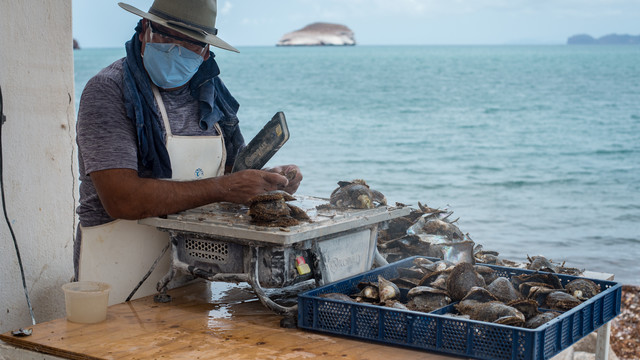Why food diversity must be on the menu
As World Food Day approaches, Seth Cook explores the dangers of losing local crop and animal varieties and what we can do about it.


The fruit market is dominated by a small number of varieties that can withstand long distance shipping and meet supermarket demands for uniformity (Photo: Dirk Loop, Creative Commons via Flickr)
The Itanoní Antojeria y Tortilleria in Oaxaca, Mexico may seem like an ordinary restaurant, but it's places like these that could be just what's needed to reclaim diversity in our fields, and on our plates. The restaurant makes its tortillas from eight different maize varieties sourced directly from local farmers and stone-ground by the cooks.
Restaurants such as these – along with a growing assortment of similar initiatives, from farmers' markets to box schemes and heritage seed-saving efforts – are an urgently needed antidote to the seemingly inexorable momentum towards standardisation and uniformity in farming over the past few decades.
Much of the food produced today is grown in monocultures – vast fields of a single crop – that make it easier to mechanise planting and harvesting, while meeting imperatives to maximise profits in competitive markets.
Supermarket demands for standardisation in shipping, packaging and display put a premium on produce that is uniform in shape and appearance. Producers are under pressure to focus on a small number of crop varieties that meet these criteria – those that do not are rejected.
Appearance and high-performance dominates
The fruit market epitomises the dominance of a small number of varieties, favoured for their appearance and ability to withstand long distance shipping. There are more than 1,000 banana varieties in the world, but just one variety – the Cavendish – accounts for 95 per cent of the global banana export market.
Only four commercial varieties of apples – Golden Delicious, Red Delicious, Gala and Granny Smith – currently make up 90 per cent of the world market. Of the 2,500 types of pears that were grown in the past, just two account for 96 per cent of the market.
The same trends are operating in animal husbandry. A small number of high-performance breeds have spread throughout the world since the mid-20th century, in many cases replacing local breeds. These include Rhode Island Red and Leghorn chickens, Large White, Duroc and Landrace pigs, Saanen goats and Holstein Friesian and Jersey cattle.
Local varieties at risk
The result is that the many local varieties and breeds – plants and animals well-adapted to their local conditions and therefore less reliant on chemical fertilisers, pesticides and antibiotics – have been replaced by a small number of "improved" ones.
In Sri Lanka, some 2,000 varieties of rice were grown up until 1959; 40 years later only five varieties dominated production. Some 30,000 varieties of rice were once grown in India; today less than ten varieties account for more than 75 per cent of production.
In the livestock sector, an increasing number of local breeds are also at risk of displacement. For instance, of the 14 local pig breeds in Vietnam, five are considered vulnerable, two are in a critical state, and three are at risk of extinction.
Globally, nearly 17 per cent of livestock breeds are at risk of extinction. Many of these are indigenous breeds that are an important part of agricultural and pastoral traditions, even if they are not as productive under favourable circumstances as exotic breeds. Local breeds tend to be less costly to raise than exotic breeds, and are more able to survive and reproduce in harsh climates.
Lack of diversity threatens our food system
Monocultures and the increased reliance on a narrow range of crop varieties pose a significant threat to our food supply, increasing vulnerability to threats such as drought, pests and diseases, all of which are likely to intensify due to climate change. They sacrifice diversity, and in some cases taste as well.
The Cavendish banana variety is susceptible to the TR4 virus, which has ravaged plantations in much of Southeast Asia and now threatens plantations worldwide. An estimated 80-90 per cent of wheat varieties grown worldwide are susceptible to the Ug99 race of stem rust – considered a significant threat to global wheat production.
In order to safeguard against pest and disease outbreaks, as well as the threat that climatic change poses to agriculture, greater efforts are needed by governments, consumers and farmers around the world to preserve agricultural biodiversity.
While seed banks such as the Svalbard Global Seed Vault are an essential insurance policy against the loss of crop varieties and as a resource for plant breeders, they are not sufficient in themselves.
Farmers need incentives to preserve thousands of crop varieties that are in danger of being lost, which in turn entails improving market access for them
The only way to ensure that our wealth of plants and animals and their wild relatives continue to adapt to changes in the environment and pressures from pests and diseases, and act as a living genetic reservoir to meet future needs, is to maintain them in the fields. This is a far more challenging endeavour.
Farmers need incentives to preserve thousands of crop varieties that are in danger of being lost, which in turn entails improving market access for them. Restaurants such as the Itanoní Antojeria y Tortilleria have a vital role here, as do farmers markets, box schemes and food hubs. In the battle to preserve diverse foods, consumers need to vote with their fork.
- Through the Sustainable Diets for All programme, IIED and Hivos are working with citizens to promote diets that are healthier, fairer, sustainable – and more diverse.
Seth Cook (seth.cook@iied.org) is a senior researcher in IIED's agroecology and China teams. This blog was orginally posted by the Thomson Reuters Foundation.



